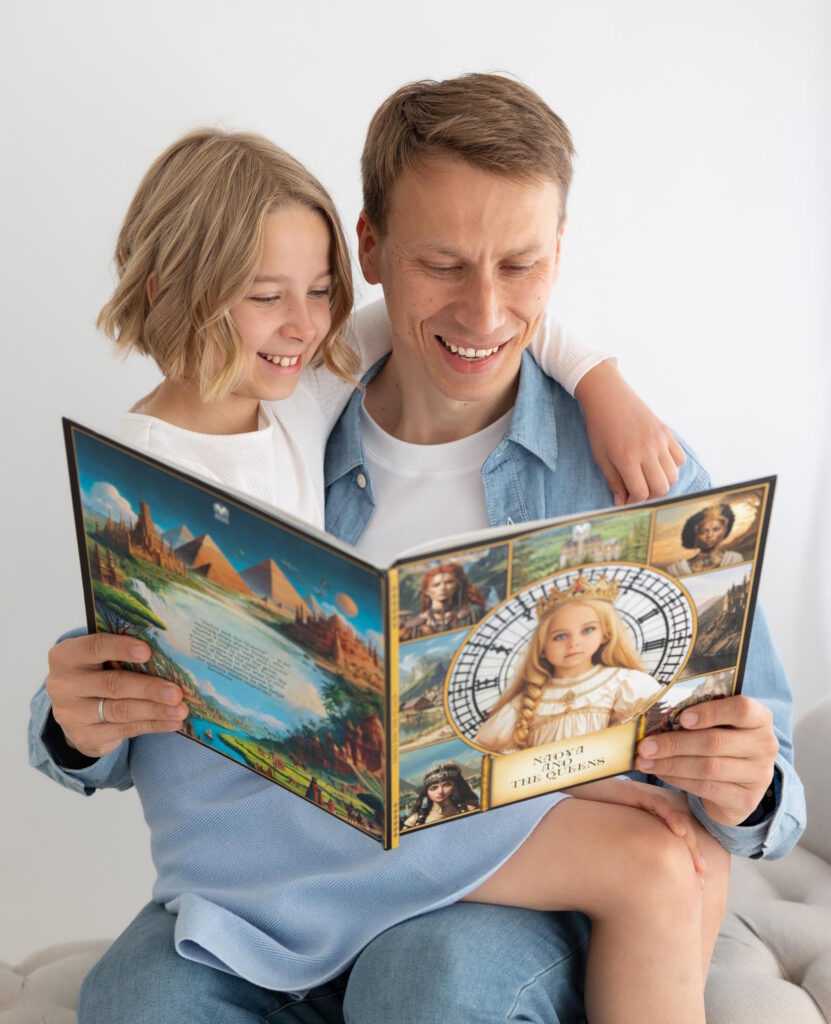History comes alive when your child becomes part of the story. Imagine them learning about Cleopatra, Elizabeth I, or Queen Victoria while seeing themselves in the pages of a personalised book. These stories not only teach about leadership and resilience but also inspire a love for reading by making history feel personal and exciting.
Key Features of Personalised Books:
- Your child’s name and appearance are integrated into the story.
- Tailored for children aged 2–16 with options for softcover and hardcover formats.
- Educational benefits: Boosts reading comprehension by 40% and nurtures curiosity.
Meet 5 Iconic Queens in These Stories:
- Cleopatra – Explore the Nile and learn about leadership and cultural understanding.
- Elizabeth I – Discover how intelligence and bravery shaped England’s Golden Age.
- Queen Victoria – Understand her role in transforming Britain and her focus on family.
- Nefertiti – Learn about her influence in ancient Egypt’s religious transformation.
- Catherine the Great – See how she expanded Russia and championed education.
These books connect your child to history through engaging narratives and vibrant illustrations, making learning both fun and memorable.
British Queens through History for Kids
Why Personal Stories Make History Real
According to the National Literacy Trust, when children see themselves in historical stories, their reading comprehension improves by over 40%. It also helps them feel more connected to literature. Dr Natascha Crandall notes that personalisation brings out children’s existing strengths.
Children who regularly read personalised books can be up to three years ahead in reading age by the time they turn 14.
These books often include features like:
- Character customisation: Over 200 options for hair, eye, and skin tones
- Name integration: The child’s name appears throughout the story
- Personal touches: A custom dedication and photo on the back cover
- Eco-conscious production: FSC-certified materials and carbon-offset printing
Aamna, a mum, shares how these stories resonate with her child:
“Your stories also always have a great moral or something to teach and make the experience of reading and learning more relatable for the child through visualizing themselves as the main character.”
Up next: five inspiring queens your child can encounter in these personalised tales.
1. Cleopatra: Last Pharaoh of Egypt
Cleopatra VII, born in 69 B.C., became co-ruler of Egypt at just 18 years old and is remembered as the last ruler of the Ptolemaic dynasty.
“In Cleopatra, we see a woman who refused to be defined by her circumstances, forging her path with courage and grace. She is not just a symbol of Egypt’s past but a timeless example of leadership, strategy, and resilience.” – Mahiraj Jadeja
Cleopatra’s life offers children valuable lessons:
- Respect for different cultures: She worked to blend Egyptian and Greek traditions, creating a bridge between two ancient civilisations.
- Commitment to education: Cleopatra studied at the renowned Mouseion in Alexandria, showcasing her dedication to learning.
- Leadership in adversity: She defended her kingdom with wisdom and determination during difficult times.
By imagining themselves walking through Alexandria’s great halls with young Cleopatra, children can explore themes of perseverance, cultural understanding, and the importance of education.
Next, learn about Elizabeth I: the Tudor queen who transformed England.
2. Elizabeth I: Tudor Queen of England
Elizabeth I stands as a shining example of how intelligence and bravery can shape a nation. She became queen in 1558 at just 25 years old, ushering in England’s Golden Age during her remarkable 45-year reign. Her leadership proved that women could govern with the same effectiveness as men.
“I know I have but the body of a weak and feeble woman, but I have the heart and stomach of a king, and of a king of England too.” – Elizabeth I
As a young girl, Elizabeth was a dedicated learner, mastering six languages, including French and Italian. Her story shows children that hard work and a passion for learning can lead to extraordinary achievements.
Her time as queen teaches two key lessons:
- Leading in Challenging Times
Elizabeth’s leadership shone during the defeat of the Spanish Armada, a fleet of over 100 ships, showing the power of resilience and strategy. - Breaking Boundaries
By ruling independently and seeking wise counsel, she demonstrated confidence and careful decision-making, paving the way for future female leaders.
“She is only a woman, only mistress of half an island, and yet she makes herself feared by Spain, by France, by the Empire, by all”.
“I mean to direct all my actions by good advice and counsel”.
Interactive stories allow children to step into Elizabeth’s shoes – whether delivering a court speech or exploring London’s bustling docks – helping them absorb her confidence and determination.
Next: Discover Queen Victoria, whose reign transformed Britain.
3. Queen Victoria: Britain’s Longest‑Reigning Monarch
Queen Victoria (1837–1901) played a key role in shaping Britain into a global powerhouse. Her reign not only expanded the British Empire but also revitalised the monarchy’s image through her dedication to public service and support for over 150 institutions.
Here are some key highlights of her life that resonate with younger audiences:
- A young queen’s journey
On the day of her coronation, an estimated 400,000 Londoners gathered along the streets to catch a glimpse of their new queen. This moment marked the beginning of the Victorian era, a period that would leave an indelible mark on history. - A focus on family
Victoria and her husband, Prince Albert, had nine children over 16 years. The couple also embraced the relatively new trend of family photography, offering a glimpse into their personal lives. - A global influence
During her reign, the British Empire expanded to cover about a quarter of the world’s landmass and governed around 400 million people.
Stories of Victoria’s determination and vision can inspire children, showing them that dedication and hard work can make a lasting impact.
Next: Meet Nefertiti, the legendary Egyptian queen whose beauty and power continue to captivate imaginations.
sbb-itb-bcf4b6b
4. Nefertiti: Queen of the 18th Dynasty
Nefertiti, whose name means “the beautiful one has come”, ruled alongside Akhenaten from 1353–1336 BC. She rose from Great Royal Wife to co-ruler, becoming one of ancient Egypt’s most influential figures. Her reign is a striking example of women taking on transformative roles in history. Much like Cleopatra, Nefertiti broke barriers to shape Egypt’s destiny.
During the Amarna period (1349–1336 BC), she played a key role in Egypt’s religious transformation, shifting the focus to a single deity, Aten. This shift was so impactful that she was honoured with her own temple and held equal status in the worship of Aten. Imagine standing in the Temple of Aten, watching priests perform rituals under her guidance.
When German archaeologist Ludwig Borchardt unearthed her iconic limestone bust at Amarna, its intricate detail and vibrant colours left him astonished. Some historians believe she may have taken on the role of pharaoh after Akhenaten’s death, showcasing her determination and bold leadership.
Next: Catherine the Great, Empress of Russia.
5. Catherine the Great: Empress of Russia
Catherine II, born in Prussia in 1729, ruled Russia for 34 years, making her reign the longest of any female monarch in the country’s history. Although she wasn’t Russian by birth, she fully embraced her new homeland, learning the language and converting to Russian Orthodoxy.
She made education a priority, establishing the Smolny Institute for Noble Maidens – the first public school for women in Russia. Here, 200 students studied subjects like geometry and fine art, reflecting her commitment to Enlightenment ideals.
Catherine also encouraged open discussions, believing that honest debates led to better decision-making. Her reign was a golden age for the arts, with her founding the Hermitage Museum and the Bolshoi Theatre – both of which remain iconic cultural landmarks today.
By the time her reign ended, Catherine had expanded Russian territory by roughly 200,000 square miles, solidifying the empire’s place as a major European power.
Her epitaph hints at her relentless ambition to win affection – from her husband, her predecessor, and the Russian people – showing the personal drive behind her political achievements.
“In your plans for reform, you are forgetting the difference between our two positions: you work only on paper which accepts anything, is smooth and flexible and offers no obstacles either to your imagination or your pen, while I, poor empress, work on human skin, which is far more sensitive and touchy.” – Catherine the Great
Through Catherine’s story, children can explore themes of determination, curiosity, and the transformative power of education – lessons they can apply to their own adventures.
Next: Stories that teach history through these remarkable lives.
Stories That Teach History
Personalised historical stories resonate with how children naturally process information – connecting past events to personal experiences, which helps deepen their understanding and ignite curiosity.
These narratives align with educational goals by illustrating how queens influenced societal and cultural shifts, demonstrated leadership under pressure, and encouraged critical thinking to develop research skills. They also nurture empathy by allowing readers to see the world through diverse perspectives.
Fableau‘s The Queens covers 3,000 years of history, highlighting women’s accomplishments – from temple builders to cultural pioneers. Up next: discover the book options that bring these queens’ stories to life.
Conclusion
With your choice of format – softcover, hardcover, or premium – Fableau’s personalised stories take your child on a journey from Cleopatra’s Nile to Victoria’s coronation. By featuring your child alongside these iconic queens in detailed, customised illustrations, history shifts from distant facts to an exciting personal adventure.
Studies indicate that when children are the main characters in their stories, they show higher levels of interest and engagement in reading. These royal adventures help boost confidence, ignite imagination, and nurture a lasting passion for books.








